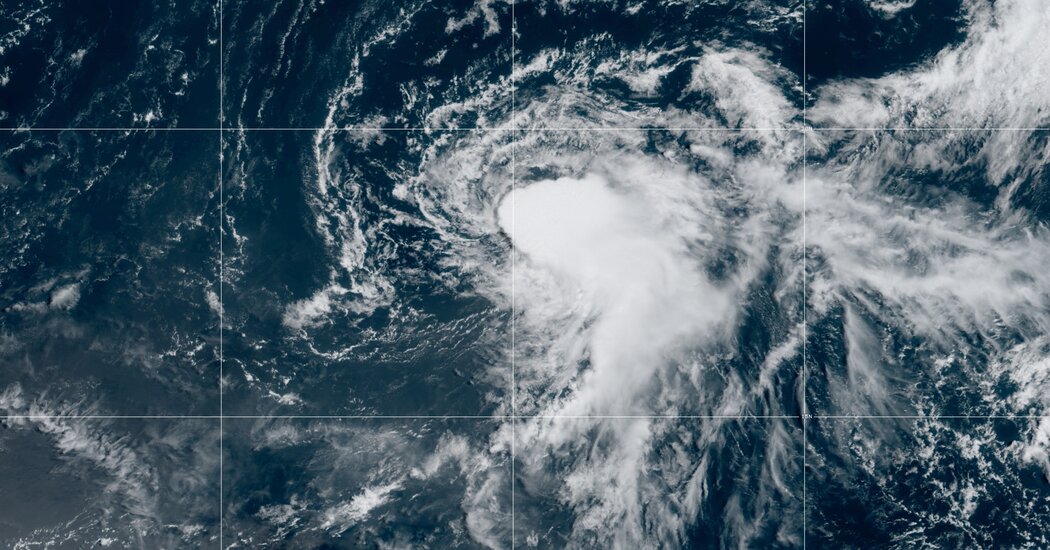
Julian, which formed as a tropical storm in the Atlantic on Sunday while another, more powerful storm was bearing down on the Louisiana coast, had transitioned into a post-tropical cyclone by early Monday, the National Hurricane Center said. It was, briefly, the 10th named storm of the 2021 Atlantic hurricane season.
The storm emerged over the weekend while Louisiana was braced for Hurricane Ida, which made landfall on Sunday, the 16th anniversary of Hurricane Katrina.
Julian was expected on Monday to move toward the northeast followed by a turn to the north, then northeast by nightfall into Tuesday, meteorologists said. On Monday morning it was 820 miles southeast of Cape Race, Newfoundland, with maximum sustained winds of 60 miles per hour. No costal watches or warnings were in effect. Hours after Julian was downgraded, Tropical Storm Kate formed over the Atlantic.
It’s been a dizzying few weeks for meteorologists who monitored several named storms that formed in quick succession in the Atlantic, bringing stormy weather, flooding and damaging winds to different parts of the United States and the Caribbean.
Tropical Storm Fred made landfall on Aug. 16 in the Florida Panhandle. As Fred moved across the southeast, it brought heavy rains and touched off several tornadoes. At least five people were killed after flash floods wiped out homes in Western North Carolina in the wake of the storm.
Grace formed in the eastern Caribbean on Aug. 14, the same day a 7.2-magnitude earthquake rocked Haiti’s western peninsula. The storm quickly moved west as the country struggled to free people trapped in rubble, dumping at least 10 inches of rain. Grace then made another landfall on the Yucatán Peninsula in Mexico, bringing more heavy rain, power failures and hundreds of evacuations.
Another landfall, on the eastern coast of Mexico’s mainland, left at least eight people dead.
And Henri formed on Aug. 16 as a tropical storm off the East Coast of the United States. It strengthened into a Category 1 hurricane but was downgraded before making landfall in Rhode Island, sparing the region the worst of what had been predicted. It thrashed the Northeast with fierce winds and torrential rain, knocking out power to more than 140,000 households from New Jersey to Maine.
Extreme Weather
Ana became the first named storm of the season on May 23, making this the seventh year in a row that a named storm developed in the Atlantic before the official start of the season on June 1.
The links between hurricanes and climate change are becoming more apparent. A warming planet could expect to have stronger hurricanes over time, and a higher incidence of the most powerful storms — though the overall number of storms could drop, because factors like stronger wind shear could keep weaker storms from forming.
Hurricanes are also becoming wetter because of more water vapor in the warmer atmosphere; scientists have suggested storms like Hurricane Harvey in 2017 produced far more rain than they would have without the human effects on climate. Also, rising sea levels are contributing to higher storm surge — the most destructive element of tropical cyclones.
In May, scientists with the National Oceanic and Atmospheric Administration forecast that there would be 13 to 20 named storms this year, six to 10 of which would be hurricanes, and three to five major hurricanes of Category 3 or higher in the Atlantic. In early August, in a midseason update to the forecast, they continued to warn that this year’s hurricane season would be an above average one, suggesting a busy end to the season.
Matthew Rosencrans, of the NOAA, said that an updated forecast suggested that there would be 15 to 21 named storms, including seven to 10 hurricanes, by the end of the season on Nov. 30. Julian is the 10th named storm of 2021.
Last year, there were 30 named storms, including six major hurricanes, forcing meteorologists to exhaust the alphabet for the second time and move to using Greek letters.
It was the highest number of storms on record, surpassing the 28 from 2005, and included the second-highest number of hurricanes reported in history.
Derrick Bryson Taylor contributed reporting.

